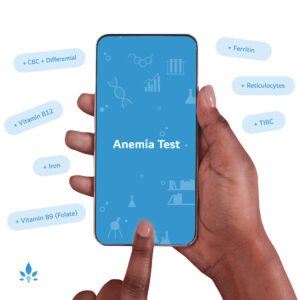What Causes Anemia in Babies?
Red blood cells (RBCs) share a similar mission in adults and children: to carry oxygen and nutrients throughout the body. However, a newborn baby’s RBCs have a shorter lifespan than an adult’s, which can contribute to anemia.
Anemia is a condition where RBC counts are lower than normal. This shortened lifespan can explain why many babies experience anemia around 6-10 weeks after they are born. When a baby experiences lower blood counts in the months after birth, this effect is known as physiologic anemia. Physiologic anemia occurs in nearly all babies, and most babies do not require treatment as their bodies start to make new RBCs at about four weeks of age.
However, there are other reasons a baby may experience anemia. For example, premature babies often experience anemia because they did not have as many RBCs as a full-term baby would when they were born, often referred to as anemia of prematurity. Older infants may be deficient in iron, the building block to make RBCs. Additional anemia causes in infants include:
Blood loss during delivery, such as losing blood to the placenta or mother’s bloodstream
Blood loss due to frequent lab draws for blood testing
Mother and baby do not have the same blood type, which can cause rapid RBC destruction.
Most babies are not treated for anemia unless they have concerning symptoms. Because RBCs are responsible for transporting oxygen, many anemia symptoms are related to breathing or low oxygen intake. Anemic babies may:
Appear pale or have yellow-tinged skin
Act lethargic or do not appear to have energy to move
Breathe at a faster rate
Have faster than normal heart rates
Have feeding difficulties and become tired when feeding
If a physician suspects an infant is experiencing anemia, he or she may perform blood tests, such as a complete blood count (CBC), serum iron, and total iron binding capacity. The CBC tests the amount of RBCs in the blood while the iron tests can determine if lack of iron is an anemia cause.
Children who have symptoms, especially feeding difficulties related to their anemia, should be treated. When anemia is left untreated, a child can experience delayed growth and development, poor motor skills, and behavioral issues. Treatments can include increasing iron intake for breastfeeding mothers or ensuring a baby is eating an iron-fortified formula or cereal. If babies are given cow’s milk before age 1, they could miss out on important iron intake, leading to anemia.
Some babies may require medical interventions, such as blood transfusions or iron supplementation. Premature infants can also receive erythropoietin, a hormone that influences RBC production. When detected and monitored, anemia in infants and babies is a highly treatable condition.
Sources:
- American Family Physician
- Prevention of Iron Deficiency in Infants and Toddlers.
KidsHealth - Iron-Deficiency Anemia.
Lab Tests Online - Screening Tests for Infants.
MedlinePlus - Anemia Cause By Low Iron – Children.
Summit Medical Group - Newborn Anemia.
Powered by Bundoo®













































